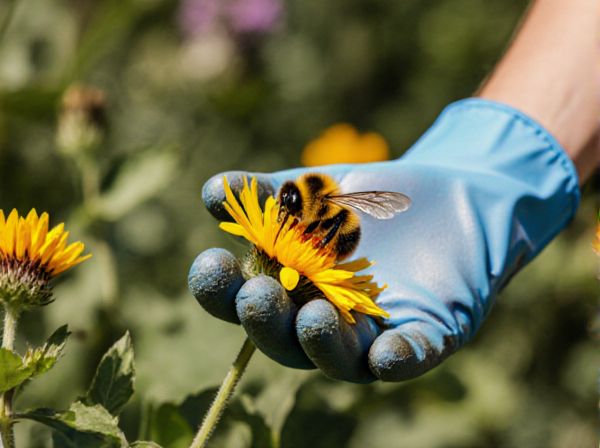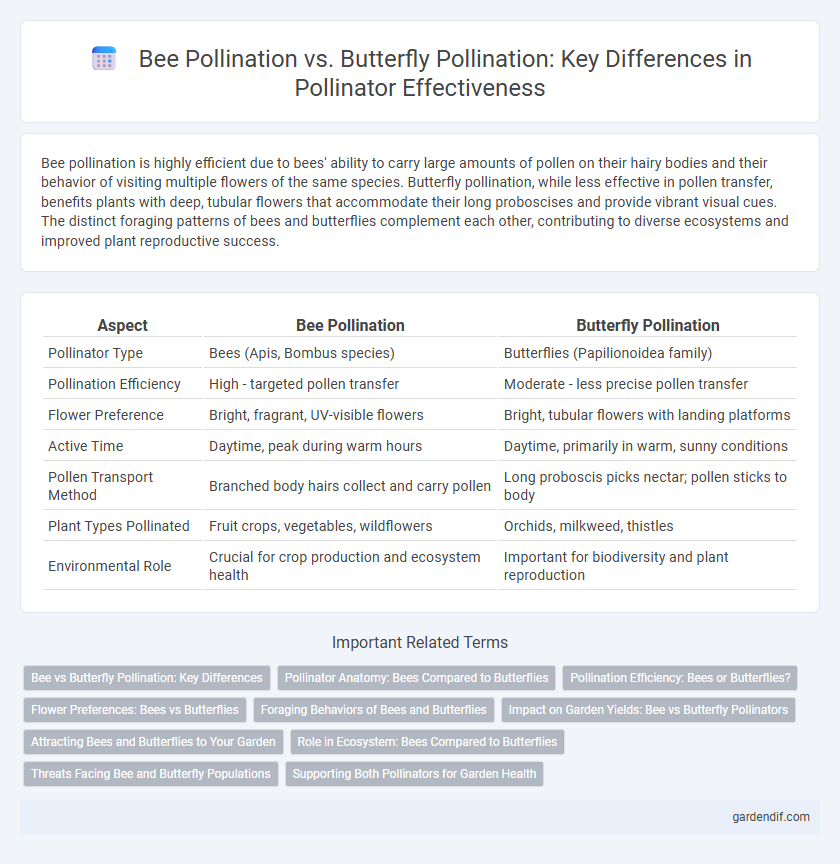
Bee pollination vs butterfly pollination Illustration
Bee pollination is highly efficient due to bees' ability to carry large amounts of pollen on their hairy bodies and their behavior of visiting multiple flowers of the same species. Butterfly pollination, while less effective in pollen transfer, benefits plants with deep, tubular flowers that accommodate their long proboscises and provide vibrant visual cues. The distinct foraging patterns of bees and butterflies complement each other, contributing to diverse ecosystems and improved plant reproductive success.
Table of Comparison
| Aspect | Bee Pollination | Butterfly Pollination |
|---|---|---|
| Pollinator Type | Bees (Apis, Bombus species) | Butterflies (Papilionoidea family) |
| Pollination Efficiency | High - targeted pollen transfer | Moderate - less precise pollen transfer |
| Flower Preference | Bright, fragrant, UV-visible flowers | Bright, tubular flowers with landing platforms |
| Active Time | Daytime, peak during warm hours | Daytime, primarily in warm, sunny conditions |
| Pollen Transport Method | Branched body hairs collect and carry pollen | Long proboscis picks nectar; pollen sticks to body |
| Plant Types Pollinated | Fruit crops, vegetables, wildflowers | Orchids, milkweed, thistles |
| Environmental Role | Crucial for crop production and ecosystem health | Important for biodiversity and plant reproduction |
Bee vs Butterfly Pollination: Key Differences
Bee pollination is highly efficient due to bees' hairy bodies that trap pollen effectively, promoting cross-pollination and boosting plant reproductive success. Butterfly pollination relies on their long proboscises to reach nectar in deep flowers, but they carry less pollen because their bodies are smoother and less hairy. Bees tend to visit more flowers per foraging trip, increasing pollen transfer, while butterflies often prefer brightly colored flowers with a landing platform, influencing pollination patterns in different plant species.
Pollinator Anatomy: Bees Compared to Butterflies
Bees have branched, hairy bodies and specialized pollen baskets called corbiculae on their hind legs, which efficiently collect and transport pollen. Butterflies possess long, slender proboscises adapted for sipping nectar, but their smooth bodies are less effective at pollen transfer. These anatomical differences result in bees being more effective pollinators for a wider range of flowering plants than butterflies.
Pollination Efficiency: Bees or Butterflies?
Bees exhibit higher pollination efficiency compared to butterflies due to their hairy bodies, which trap and transfer more pollen between flowers. Their foraging behavior involves repetitive visits to the same flower species, enhancing targeted pollination. Butterflies, with smoother bodies and wider foraging patterns, generally contribute less effectively to pollen transfer despite visiting diverse plants.
Flower Preferences: Bees vs Butterflies
Bees primarily prefer flowers with bright blue, purple, and yellow hues that have sweet scents and abundant nectar, often favoring tubular or clustered shapes ideal for their pollination behavior. Butterflies are drawn to brightly colored flowers, especially red, orange, and pink, with strong scents and shallow, flat blooms that accommodate their long proboscis and landing needs. The distinct flower preferences between bees and butterflies influence plant-pollinator interactions and biodiversity in ecosystems.
Foraging Behaviors of Bees and Butterflies
Bees exhibit highly efficient foraging behaviors characterized by flower constancy and targeted pollen collection, which enhances pollination efficiency by visiting flowers of the same species repeatedly. In contrast, butterflies engage in more varied flower visitation patterns with longer flight distances between flowers, relying heavily on nectar rather than pollen collection, resulting in less effective pollen transfer. The specialized role of bees in foraging supports critical pollination services in agricultural ecosystems, while butterflies contribute mainly to biodiversity maintenance through their generalist feeding habits.
Impact on Garden Yields: Bee vs Butterfly Pollinators
Bee pollination significantly boosts garden yields by efficiently transferring pollen among flowers, resulting in higher fruit and vegetable production compared to butterfly pollination. Bees have specialized body structures that collect and deposit pollen more effectively, enhancing fertilization rates in crops. In contrast, butterfly pollination contributes less to yield increases due to their lighter pollen load and less frequent flower visits, making bees the primary pollinators for maximizing garden productivity.
Attracting Bees and Butterflies to Your Garden
To attract bees effectively, plant native wildflowers such as clover, lavender, and sunflowers, which provide abundant nectar and pollen. Butterflies prefer brightly colored, fragrant flowers like milkweed, zinnias, and butterfly bush that offer landing platforms and nectar-rich blooms. Creating diverse habitats with varied flowering plants supports both bee and butterfly populations, enhancing pollination and garden biodiversity.
Role in Ecosystem: Bees Compared to Butterflies
Bees play a crucial role in ecosystems by efficiently pollinating a wide variety of crops and wild plants, significantly boosting biodiversity and agricultural productivity. Their hairy bodies are adapted to carry large amounts of pollen, making them primary pollinators for many flowering plants. Butterflies contribute to pollination as well but are less effective due to their smoother bodies and preference for specific flowers, resulting in a more limited impact on overall ecosystem pollination.
Threats Facing Bee and Butterfly Populations
Bee populations face threats from habitat loss, pesticide exposure, and climate change, which significantly reduce their ability to pollinate effectively. Butterfly populations encounter similar challenges, including habitat fragmentation and pesticide use, but their sensitivity to environmental changes makes them particularly vulnerable. Both pollinators are essential for ecosystem health, and their declining numbers disrupt plant reproduction and biodiversity.
Supporting Both Pollinators for Garden Health
Bee pollination is highly efficient due to bees' hairy bodies that trap pollen, facilitating cross-pollination among a variety of flowering plants. Butterfly pollination, while less efficient, enhances garden biodiversity by visiting flowers with long nectar tubes that bees often cannot access. Supporting both pollinators involves planting a diverse range of native flowering plants that bloom across seasons, providing nectar and habitat to sustain robust populations and promote overall garden health.
Bee pollination vs butterfly pollination Infographic

 gardendif.com
gardendif.com